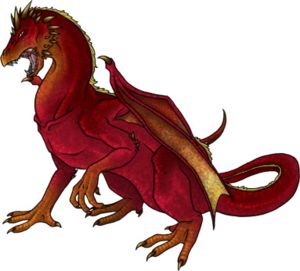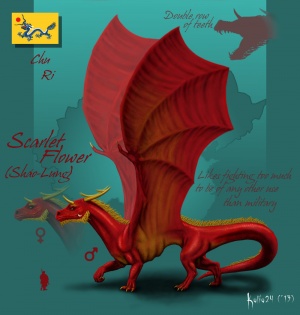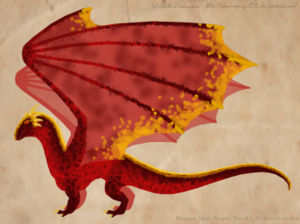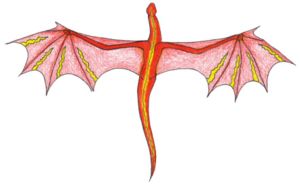Difference between revisions of "Scarlet Flower"
m |
|||
| Line 1: | Line 1: | ||
[[Image:Scarletflower.jpg|thumb|300px|Scarlet Flower, by merangue]] | [[Image:Scarletflower.jpg|thumb|300px|Scarlet Flower, by merangue]] | ||
| + | [[Image:ScarletFlower byKalia|thumb|300px|Scarlet Flower, by Kalia]] | ||
[[Image:Scarlet Flower cj.jpg|thumb|300px|Scarlet Flower, by Drummergirl375]] | [[Image:Scarlet Flower cj.jpg|thumb|300px|Scarlet Flower, by Drummergirl375]] | ||
[[Image:Scarletflower2.jpg|thumb|300px|Scarlet Flower, by Mooir]] | [[Image:Scarletflower2.jpg|thumb|300px|Scarlet Flower, by Mooir]] | ||
Revision as of 09:25, 22 April 2014
Dragon Breed Data
| Breed Name: | Scarlet Flower (Shao-Lung) |
| National Loyalty: | Chinese |
| Physical Characteristics: | Red with a yellow crest along their spines |
| Special Abilities: | None |
| Known Members: | Lung Shao Chu (?) |
Species Notes
Chinese dragons used almost exclusively in the military. They are described as liking fighting so much, as to be useless for anything other than the Aerial Corps of the Chinese army. Laurence and his crew considered them to be large dragons. They are crimson red, with gold-tinted talons and a yellow crest running down their spines from a many-horned head.
Scarlet Flowers were exclusively partnered with women, not because they refused male companions, but because only women served in the Chinese Aerial Corps. This practice was defended by the legend of a woman who disguised herself as a man, became the companion of a military dragon, and saved her country from disaster. The Chinese emperor of the time having approved girls as acceptable for service with dragons, gradually, women had come to dominate the Chinese Aerial Corps.
General Lung Shao Chu is likely a Scarlet Flower. Temeraire described General Chu as an older dragon, who "peered at him from under the bristling fringe of his mane", and "his yellow crest had evidently with age sprouted a great golden-colored mane, which framed his broad flat jaws and the curving horns which bent away from his forehead, and the edges of his vermilion scales were tipped with translucence". (Blood of Tyrants, p. 199)
It is also likely that most of the red dragons, especially the Imperial guards, mentioned in Blood of Tyrants were also Scarlet Flowers. Much, if not all, of the Chinese military was also revealed to be female.
Real History
The legend of the woman likely is that of Fa Mulan (花木蘭) (Huā Mùlán in Pinyin), a legendary figure from ancient China who was originally described in a Chinese poem known as the Ballad of Mulan (木蘭辭). In the poem, Huā Mùlán takes her aged father's place in the army. She fought for twelve years and gained high merit, but she refused any reward and retired to her hometown instead.
The historical setting of Huā Mùlán is uncertain. The earliest accounts of the legend state that she lived during the Northern Wei dynasty (386–534). The original ballad was expanded into a novel during the late Ming Dynasty (1368–1644). Over time, the story of Huā Mùlán rose in popularity as a folk tale among the Chinese people on the same level as the Butterfly Lovers. It is one of the first poems in Chinese history to support the notion of gender equality.



